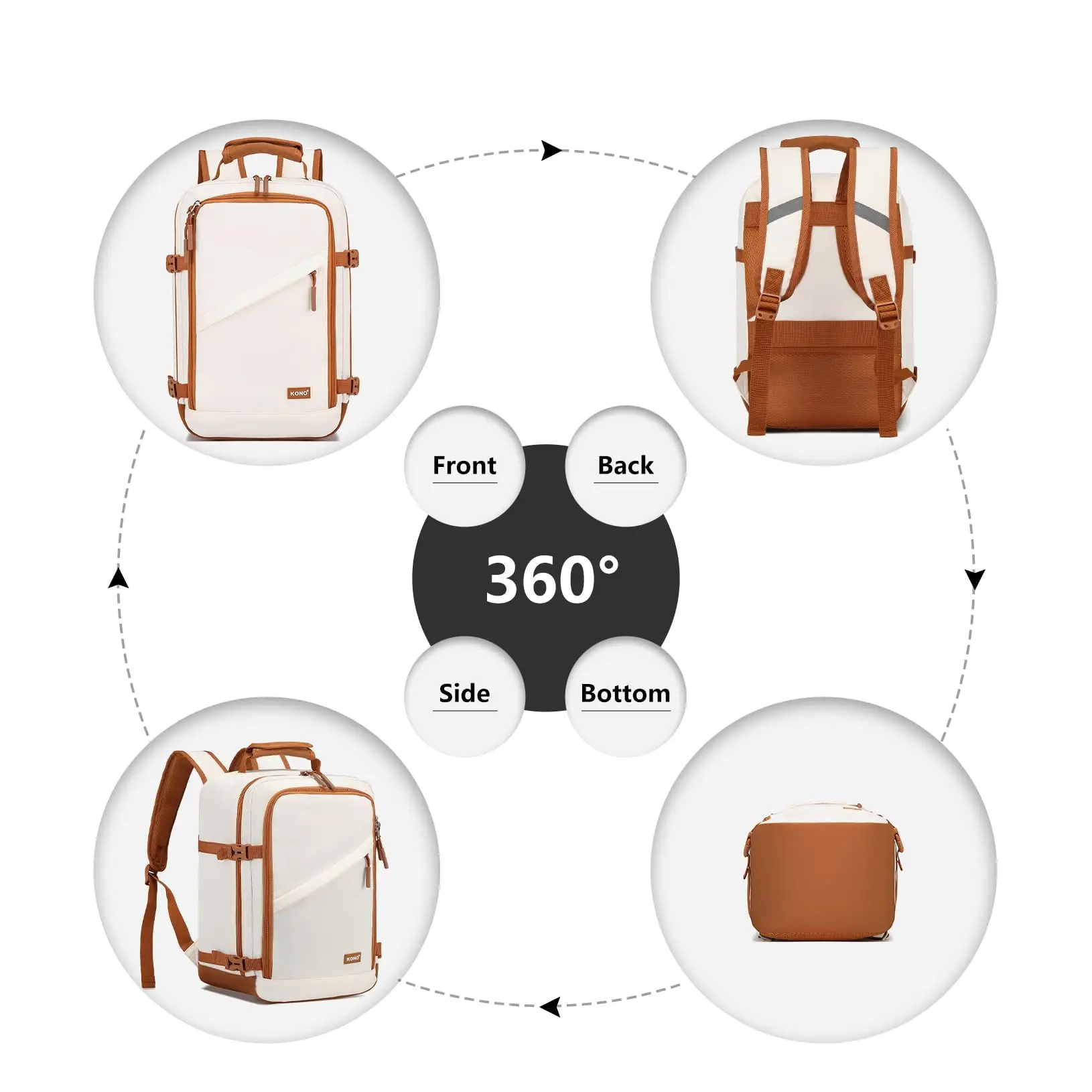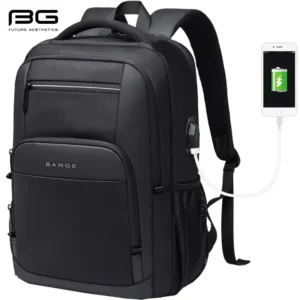1. Why Backpack Size Matters for Comfort and Performance
Finding the perfect backpack size isn’t just about having enough room for your gear—it’s about protecting your body and enhancing your overall experience. When a backpack fits properly, it distributes weight evenly across your strongest body parts, particularly your hips and core. This proper weight distribution prevents strain on your shoulders, neck, and back that can lead to pain during and after your journey.
An ill-fitting backpack can cause immediate discomfort through pressure points and chafing, but the long-term consequences are even more concerning. Over time, repeatedly carrying an improperly sized pack can contribute to chronic back pain, posture problems, and even nerve compression. For outdoor enthusiasts and frequent travelers, these issues can significantly limit future adventures.
The performance benefits of a well-fitted pack are equally important:
- Better balance and stability on uneven terrain
- Reduced fatigue allowing you to travel farther with less effort
- Improved accessibility to essential items without removing your pack
- Enhanced mobility with less restriction to your natural movement
The concept of “right-sizing” is about finding the sweet spot between having adequate capacity for your gear and maintaining a comfortable, body-appropriate fit. As research from hiking and backpacking studies shows, a properly fitted pack can transfer approximately 80% of the weight to your hips, leaving only 20% on your shoulders—a difference you’ll feel within minutes on the trail.
Understanding proper backpack weight distribution techniques is just as important as selecting the right size, as they work together to create a comfortable carrying experience.
2. Understanding Backpack Volume: What Do Liters Really Mean?
Backpack capacity is most commonly measured in liters, representing the total volume of space available inside the pack. This standardized measurement helps you compare different models across brands, though understanding what these numbers mean practically can be challenging for beginners.
A liter (often abbreviated as “L”) equals about 61 cubic inches. While some American manufacturers still use cubic inches, the international standard has largely shifted to liters. Here’s a simple conversion to help:
| Liters | Cubic Inches (approximate) |
|---|---|
| 10L | 610 cubic inches |
| 20L | 1,220 cubic inches |
| 30L | 1,830 cubic inches |
| 40L | 2,440 cubic inches |
| 50L | 3,050 cubic inches |
To visualize capacity in practical terms, a 20-liter backpack can hold approximately eight standard 1-liter water bottles or enough supplies for a day hike with lunch, extra layers, and essentials. A 40-liter pack might carry enough for an overnight trip with basic camping gear.
Be aware that manufacturers sometimes measure volume differently. Some count every pocket and compartment in their total liter rating, while others only measure the main compartment. The industry standard (ASTM F2153) attempts to standardize these measurements, but variations still exist between brands.
Additionally, compression straps can significantly affect usable volume. A 50-liter backpack with good compression can be cinched down when partially full, providing versatility for different trip lengths. This feature is particularly valuable in mini leather backpacks where maximizing limited space becomes essential.
Understanding these volume basics provides the foundation for choosing the right size for your specific needs, which we’ll explore in the following sections.
3. Trip Duration: How Long Are You Going For?
The length of your journey is perhaps the most significant factor in determining what size backpack you’ll need. Each duration category has general volume requirements based on the gear, food, and supplies typically needed.
Day Trips (Under 24 Hours)
For short adventures that don’t require overnight gear, smaller packs are usually sufficient:
– 15-25 liters: Perfect for essentials like water, snacks, extra layers, and personal items
– 25-30 liters: Ideal for day hikes in variable weather, photography equipment, or family outings where you’re carrying items for others
What fits: A rain jacket, lunch, first aid kit, 2-3 water bottles, camera, and personal items
Weekend Trips (1-2 Nights)
Once you add sleeping gear and additional food, your space needs increase considerably:
– 30-45 liters: Sufficient for minimalist packers with lightweight gear
– 45-50 liters: More comfortable for standard camping equipment and variable weather conditions
What fits: Sleeping bag, small tent or hammock, sleeping pad, cooking equipment, 2-3 days of food, extra clothing layers, and personal items
Multi-Day Trips (3-5 Nights)
Longer journeys require more supplies, particularly food and fuel:
– 50-65 liters: Typical sweet spot for most multi-day backpackers
– 65-70 liters: Better for less experienced packers or those bringing more comfort items
What fits: Everything from a weekend trip plus additional food, potentially more substantial shelter, extra clothing for varied conditions, and more extensive first aid/emergency supplies
Extended Expeditions (5+ Nights)
For long journeys, especially in remote areas without resupply:
– 70-85 liters: Standard for week-long trips or winter expeditions
– 85+ liters: Specialized needs like expedition climbing, guiding, or carrying group gear
What fits: Multiple weeks of food, comprehensive emergency supplies, technical equipment, and possibly group shared items like a larger tent
Keep in mind that access to resupply points dramatically affects your pack size needs. A thru-hiker who can resupply every few days might manage with a 50-liter pack for a months-long journey, while someone on a week-long wilderness trek with no resupply might need 70+ liters.
For those planning longer journeys, exploring high-quality leather travel backpacks can provide both the necessary volume and durability for extended adventures.
4. Activity Type: Different Adventures Require Different Capacities
The specific activity you’re undertaking often dictates specialized gear requirements that directly impact your backpack size needs. Different adventures place unique demands on your carrying system, so understanding these variations helps you choose more appropriately.
Hiking and Backpacking
Traditional trail-based activities follow the duration guidelines most closely:
– Day hiking typically requires 15-30 liters
– Overnight backpacking needs 35-50 liters
– Multi-day treks generally demand 50-70 liters
The terrain difficulty and remoteness can push you toward the higher end of these ranges, as more challenging conditions often require additional emergency gear and supplies.
Urban Travel and Air Travel
When traveling through cities or flying, different considerations apply:
– 20-35 liters: Typical for minimalist travelers and short trips
– 35-45 liters: Standard carry-on compatible size
– 45-55 liters: Extended travel with careful packing (may exceed carry-on limits)
Most airlines limit carry-on bags to approximately 22 x 14 x 9 inches (56 x 36 x 23 cm), which typically translates to about 40-45 liters maximum. The structured design of carry-on leather backpacks often makes them ideal for travelers who need organization while staying within airline restrictions.
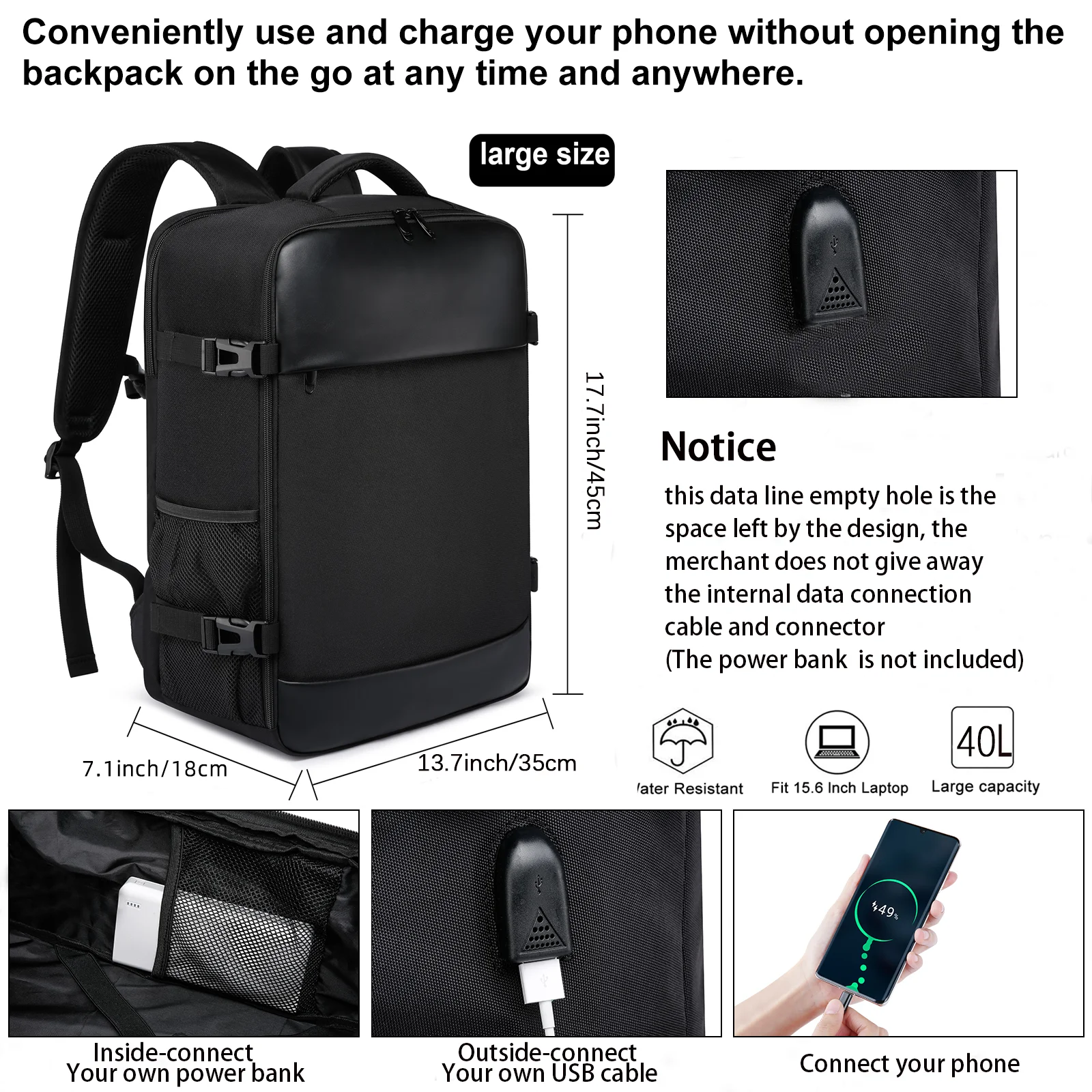
Climbing and Mountaineering
Technical climbing activities require specialized equipment:
– 25-35 liters: Single-day climbs with minimal gear
– 35-50 liters: Multi-pitch traditional climbing with protection gear
– 50-70+ liters: Alpine climbing and mountaineering with overnight equipment
These packs often feature specialized attachments for ice tools, ropes, and helmets that affect how the capacity is configured.
Daily Commuting and Everyday Use
For everyday carrying needs:
– 15-25 liters: Sufficient for most work/school commuting needs
– 25-30 liters: Accommodates larger laptops, gym clothes, and meal containers
Commuter packs prioritize organization and accessibility over sheer volume, with features like padded laptop sleeves and quick-access pockets.
Winter Activities
Cold-weather adventures demand more volume due to bulkier gear:
– Add 10-15 liters to your usual capacity for similar trip duration
– Winter sleeping bags alone can require twice the packed volume of summer models
Understanding these activity-specific requirements helps narrow down your choices. For travelers who frequently fly, learning more about carry-on backpacks with leather finish can help you balance style with airline compliance.
5. Seasonal and Environmental Factors: How Weather Affects Pack Size
The environment and season of your adventure dramatically impact the volume of gear required, making backpack size selection highly dependent on these external factors.
Summer vs. Winter Gear Volume
The difference between summer and winter equipment is substantial:
– A summer sleeping bag might compress to 4-6 liters, while a winter bag often requires 8-12 liters
– A 3-season tent typically packs 30-40% smaller than a comparable 4-season shelter
– Winter clothing layers occupy significantly more space than summer attire
This seasonal variation means you might need a 40-liter pack for a summer weekend but a 60-liter pack for the same duration in winter.
Harsh Environment Considerations
Challenging environments demand additional safety equipment:
– Desert travel requires extra water capacity (potentially adding 2-3 liters per day)
– Alpine zones necessitate extra insulation layers and emergency shelter
– Remote wilderness areas demand more comprehensive medical and repair supplies
Water Capacity Requirements
Different climates dictate varying hydration needs:
– Humid, moderate environments: 2-3 liters per day
– Hot, dry environments: 4-6+ liters per day
– High-altitude areas: 3-4 liters despite cooler temperatures (due to increased dehydration risk)
Every liter of water weighs about 2.2 pounds (1 kg), so adequate hydration in dry environments can add significant volume and weight requirements.
Food Storage Considerations
Regional wildlife concerns may necessitate specialized storage:
– Bear canisters can add 2-3 liters of non-compressible volume
– Food bags for longer trips can occupy 5-10+ liters depending on duration
– Cold-weather trips require more calorie-dense foods, adding volume per day
Properly protecting backpacks in harsh weather conditions is essential regardless of size, as is understanding the essential features of waterproof leather backpacks if you’ll be exploring in wet environments.
6. Personal Packing Style: Minimalist vs. Comfort-Oriented Approaches
Your personal approach to packing significantly impacts the backpack size you’ll need, even when trip duration and activity type remain constant. The spectrum ranges from ultralight minimalists to comfort-focused travelers, with most people falling somewhere in between.
Minimalist Approach
The “less is more” philosophy emphasizes:
– Multi-purpose gear that serves multiple functions
– Lightweight, compact equipment even at higher cost
– Accepting some comfort sacrifices for reduced weight and volume
– Careful evaluation of every item’s necessity
Minimalist packers might complete a weekend trip with a 30-35 liter pack that would leave comfort-oriented campers struggling to fit essential gear.
Comfort-Oriented Approach
The “be prepared and comfortable” approach prioritizes:
– Redundancy for critical systems (backup options)
– Full-featured gear with all conveniences
– Comfort items like camp chairs, larger cooking kits, and extra clothing
– Preparation for unexpected conditions or extended stays
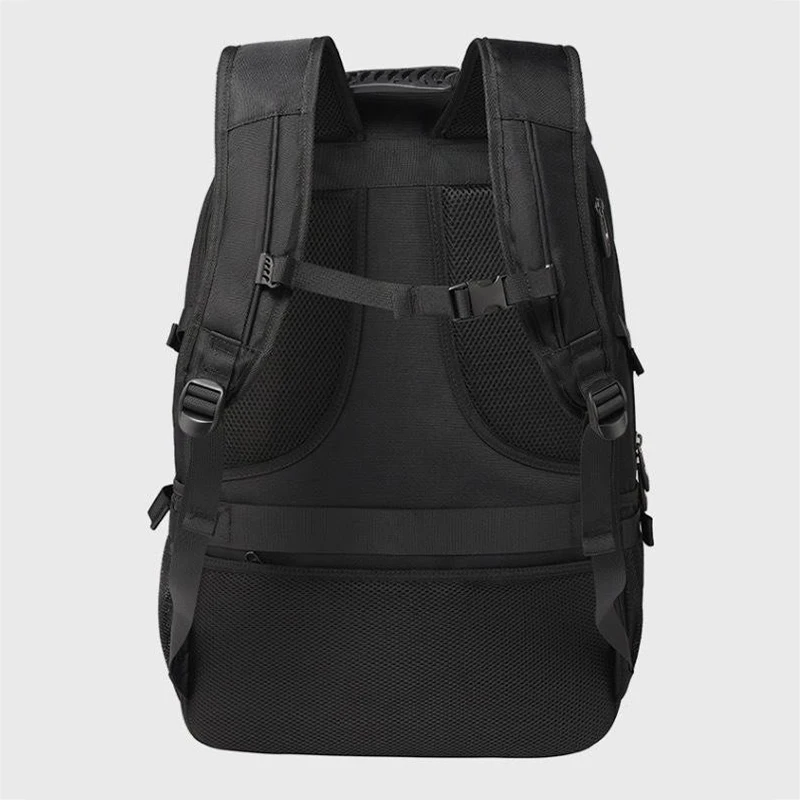
This style typically requires packs 15-20 liters larger than minimalist approaches for the same trip duration.
Experience Level Correlation
Interestingly, pack size often shrinks with experience:
– Beginners tend to overpack out of uncertainty or fear
– Experienced adventurers develop confidence in their essential systems
– Skill development allows experts to manage with less specialized equipment
– Knowledge of conditions helps avoid unnecessary “just-in-case” items
A beginner might need a 65-liter pack for a weekend, while a veteran might comfortably use a 40-liter pack for the same trip.
Whether you lean toward large leather backpacks for comfort-oriented packing or small leather backpacks for minimalist travel, matching your pack to your personal style is crucial for a satisfying experience.
7. Essential Fit: Finding Your Torso Length and Sizing Measurements
While volume capacity is important, physical fit is equally crucial for comfort and function. A perfectly-sized backpack that doesn’t fit your body will quickly become unbearable, regardless of how well it holds your gear.
Measuring Torso Length
Your torso length—not your height—is the critical measurement for backpack sizing:
- Find your C7 vertebra: Tilt your head forward and locate the large protruding bone at the base of your neck.
- Locate your iliac crest: Place your hands on your hips, with thumbs wrapping around to your back. Draw an imaginary line between your thumbs across your spine.
- Measure the distance: Have someone measure from the C7 vertebra down to the imaginary line crossing your iliac crest. This distance in inches or centimeters is your torso length.
Typical Torso Length Ranges
Backpack sizes generally follow these measurements:
– Extra Small: Up to 15.5 inches (39.5 cm)
– Small: 16-17.5 inches (40.5-44.5 cm)
– Medium: 18-19.5 inches (46-49.5 cm)
– Large: 20+ inches (51+ cm)
Hip Belt Sizing
A properly fitted hip belt is crucial for weight transfer:
1. Measure around your hips at the iliac crest (not your waist)
2. Most hip belts fit a range of measurements through adjustment
3. Specialized sizes may be needed for very small or large measurements
Gender and Body Type Considerations
Anatomical differences affect ideal pack fit:
– Women’s-specific packs typically feature narrower shoulder widths
– Contouring in the hip belt accommodates different hip angles
– Shorter average torso lengths in women’s models reflect population averages
– Some body types may fit better in gender-neutral or opposite-gender designs
Adjustable Suspension Systems
Many modern packs offer customizable fit options:
– Adjustable torso length ranges (often 3-5 inches/7.5-12.5 cm of adjustment)
– Interchangeable hip belts for perfect sizing
– Adjustable sternum strap height
– Shoulder strap curvature and width options
Maintaining your backpack’s fit over time is essential, and learning about conditioning leather backpacks helps preserve both appearance and comfort. For gender-specific options, explore women’s leather backpacks or men’s leather backpacks designed with corresponding anatomical features in mind.
8. How to Test a Backpack’s Fit: The In-Store Simulation Process
Once you’ve identified backpacks in your size range, proper testing ensures you make the right choice. Whenever possible, visit a physical store to try packs on before purchasing.
Step-by-Step Fitting Process
Prepare the pack: Loosen all straps completely—shoulder straps, load lifters, hip belt, and stabilizer straps.
Add realistic weight: Ask the store for weight bags (15-20 pounds/7-9 kg) to simulate your typical load. Many outdoor retailers provide these for testing.
Position the hip belt: Place the pack on your back and position the hip belt centered over your iliac crest (the top of your hip bones, not your waist). Tighten the hip belt firmly.
Adjust shoulder straps: Pull the shoulder straps snug but not tight—they should make full contact with your shoulders without bearing excessive weight or creating gaps.
Tighten load lifters: These small straps at the top of the shoulder straps should angle back at approximately 45° and pull the pack close to your upper back when tightened.
Secure the sternum strap: Buckle and adjust to a comfortable position across your chest, typically about 1-2 inches (2.5-5 cm) below your collarbone.
Check the fit: The shoulder straps should wrap around your shoulders without gaps, the hip belt should transfer most of the weight to your hips, and the pack should sit close to your back without excessive pressure points.
Movement Tests
Once adjusted, simulate typical activities to evaluate comfort:
– Walk around the store for several minutes
– Perform deep knee bends to check mobility
– Reach overhead to test range of motion
– Twist from side to side to assess stability
– Bend forward as if tying your shoes
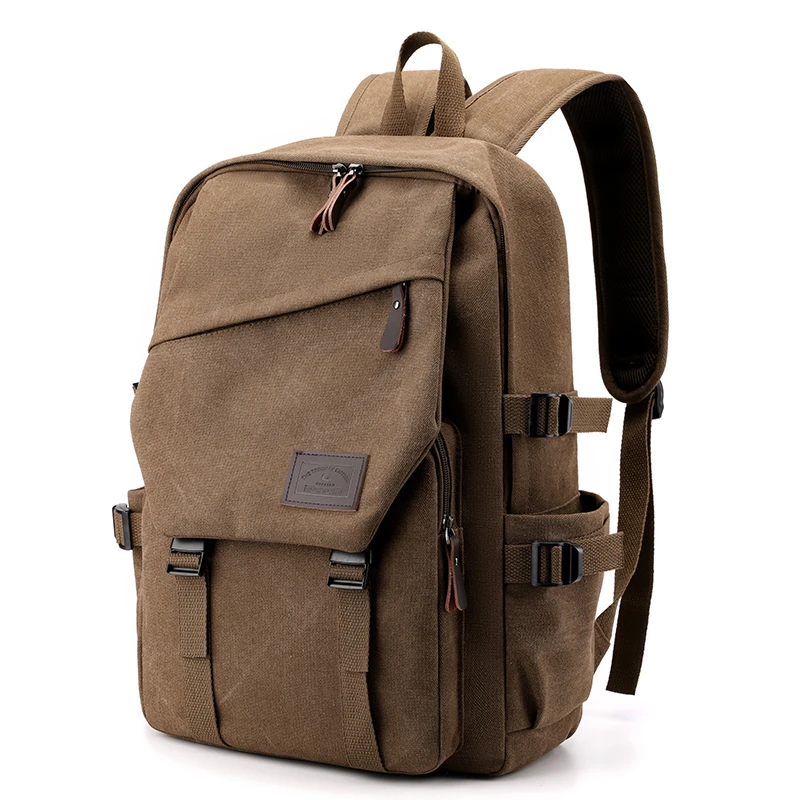
Signs of a Good Fit
- No pressure points on your shoulders, neck, or lower back
- Weight primarily felt on your hips, not shoulders
- No rubbing or chafing at contact points
- Stability when moving, without shifting or bouncing
- Back panel contours match your spine’s natural curve
Signs of Poor Fit
- Gap between shoulders and shoulder straps
- Hip belt riding too high (on waist) or too low (on thighs)
- Pressure points causing immediate discomfort
- Limited mobility when performing basic movements
- Pack shifting significantly during movement tests
For those who need to purchase online, understanding leather maintenance for daily use and DIY leather care for travel backpacks helps maintain proper fit and comfort over time.
9. Backpack Size Categories and Recommendations
To simplify selection, the backpack industry has established standard size categories that align with typical use cases. While exact volume definitions vary slightly between manufacturers, these general categories provide a useful framework for decision-making.
Daypack (Under 30 Liters)
Best For: Day hikes, commuting, school, summit packs
Typical Contents: Water, snacks, extra clothing layer, small first aid kit, personal items
Activity Examples:
– Urban exploring: 15-20 liters
– Day hiking: 20-25 liters
– Technical day climbing: 25-30 liters
Maximum Comfortable Weight: 10-15 pounds (4.5-7 kg)
Weekend Pack (30-50 Liters)
Best For: 1-3 night trips, minimalist backpacking, hut-to-hut trekking
Typical Contents: Small tent/hammock, sleeping bag, sleeping pad, cooking system, 2-3 days of food
Activity Examples:
– Ultralight overnight: 30-35 liters
– Standard weekend trip: 40-45 liters
– Winter day trip: 45-50 liters
Maximum Comfortable Weight: 25-35 pounds (11-16 kg)
Multi-Day Pack (50-70 Liters)
Best For: 3-5 night trips, bulkier gear requirements, group gear carrying
Typical Contents: All weekend gear plus additional food, more clothing options, comprehensive emergency supplies
Activity Examples:
– Summer multi-day trip: 50-60 liters
– Carrying group gear: 60-65 liters
– Mountaineering with camping: 65-70 liters
Maximum Comfortable Weight: 35-45 pounds (16-20 kg)
Extended Expedition Pack (70+ Liters)
Best For: Week+ wilderness trips, winter expeditions, professional guiding
Typical Contents: Comprehensive gear systems, extended food supplies, specialized equipment
Activity Examples:
– Week-long backpacking: 70-80 liters
– Winter expeditions: 80-90 liters
– Professional guiding: 90+ liters
Maximum Comfortable Weight: 45-60+ pounds (20-27+ kg)
Crossover Categories
Some specialized packs blur these categories:
– Travel Packs: Typically 35-45 liters with organization features prioritized over suspension systems
– Fast-and-Light Alpine Packs: 30-45 liters with minimal features but reinforced construction
– Expandable Packs: Base volume of 35-45 liters that expand to 50-60 liters when needed
Summit Carry offers a range of premium leather backpacks suitable for various needs, and understanding how to maintain leather waterproofing ensures your pack performs well regardless of size.
10. Advanced Considerations for Specialized Activities
For enthusiasts engaged in technical pursuits, standard sizing recommendations may not suffice. These specialized activities often demand unique pack configurations and features that affect volume needs.
Technical Alpine Climbing and Mountaineering
Technical pursuits in alpine environments require specific considerations:
– Equipment attachment capability often matters more than internal volume
– External carrying systems for ice tools, crampons, and helmets are essential
– Quick access to safety gear necessitates specialized pocket configurations
– Streamlined profiles for improved balance on technical terrain
– Typically 30-45 liters for day missions, 45-65 liters for overnight objectives
Photography and Equipment-Heavy Hobbies
Carrying sensitive equipment demands specialized storage:
– Padded compartments add weight and reduce usable space
– Customizable divider systems protect gear but decrease efficiency
– Quick-access features prioritized over maximum capacity
– Often require 5-10 liters more than standard recommendations
– Consider modular systems with detachable components for varying objectives
Family Hiking (Carrying Gear for Multiple People)
When responsible for others’ equipment:
– Add 5-10 liters per additional person you’re carrying gear for
– Consider asymmetrical weight distribution accommodations
– Prioritize organizational systems to separate individual items
– Look for external attachment points for bulky, lightweight items
– May require jumping up an entire size category (e.g., from weekend to multi-day pack)
Ultralight Thru-Hiking
Long-distance specialists focus on minimizing every ounce:
– Often use packs 10-20 liters smaller than standard recommendations
– Simplified suspension systems save weight but require precise packing
– Rely on frequent resupply rather than carrying capacity
– May use removable frame components for variable support
– Typically 40-55 liters even for journeys lasting months
International Travel with Variable Transportation
Global travelers face unique challenges:
– Need compatibility with various transportation security requirements
– Consider convertible designs that can be stowed as luggage
– Lockable compartments and security features add bulk but provide protection
– Anti-theft design elements may reduce usable volume
– Typically 35-45 liters for maximum versatility across transportation modes
For technology-focused activities, leather laptop backpacks offer protection with style, while those needing asymmetrical carrying options might find leather sling backpacks provide a specialized solution for certain activities.
11. Does Backpack Size Affect Weight Distribution and Comfort?
Backpack size directly influences how weight distributes across your body, affecting your center of gravity and overall comfort in ways that aren’t always intuitive. Understanding these biomechanical relationships helps explain why “bigger isn’t always better” and sometimes “too small is worse than too large.”
Center of Gravity Effects
The size of your backpack changes where weight sits relative to your body:
– Taller packs place weight higher, which can pull you backward on flat terrain
– Wider packs move weight further from your spine, reducing balance on technical terrain
– Shorter, closer-fitting packs keep weight near your natural center of gravity
– As pack height increases, your walking gait naturally compensates by leaning forward
A properly sized pack maintains your center of gravity as close as possible to its natural position, allowing more natural movement and reducing fatigue.
Balance and Mobility Impact
Different pack dimensions affect your ability to move naturally:
– Overly wide packs limit arm swing and can cause chafing
– Excessively tall packs may hit your head during lookups or restrict visibility
– Packs that are too short concentrate weight improperly on the lower back
– Well-proportioned packs allow natural rotation and bending movements
Interestingly, a slightly larger pack can sometimes improve comfort by allowing better weight distribution throughout the pack rather than concentrating it in a compressed area.
Energy Expenditure Correlation
Research shows proper sizing affects energy efficiency:
– A well-fitted pack can reduce energy expenditure by 6-10% compared to an ill-fitting one
– Every inch a pack extends outward from your back increases perceived weight by approximately 5%
– A properly sized and packed backpack minimizes shifting and bouncing, which consume extra energy
– Lower-profile designs reduce wind resistance, which becomes significant during high-speed activities or windy conditions
Understanding how proper sizing impacts weatherproofing leather bags and learning when leather should dry before conditioning ensures long-term comfort and performance.
12. Common Mistakes When Choosing Backpack Size (And How to Avoid Them)
Even experienced adventurers sometimes make sizing errors that can diminish their enjoyment and comfort. Being aware of these common pitfalls helps you avoid them in your selection process.
Buying Too Large “Just in Case”
Problem: Selecting an oversized pack creates weight distribution issues, encourages overpacking, and reduces stability.
Solution: Base your choice on your actual needs 90% of the time, not the occasional outlier trip. Consider a second specialized pack for rare requirements instead of compromising everyday performance.
Focusing on Volume While Ignoring Torso Fit
Problem: A perfectly sized 50-liter pack that doesn’t match your torso length will be more uncomfortable than a properly fitted 40-liter or 60-liter option.
Solution: Always prioritize physical fit first, then find the appropriate volume within packs that fit your body correctly.
Choosing Based Solely on Others’ Recommendations
Problem: Individual needs, body types, and packing styles vary dramatically, making direct comparisons unreliable.
Solution: Use others’ experiences as general guidance, but make your final decision based on your specific requirements and actual testing.
Underestimating Seasonal or Environmental Needs
Problem: A pack sized for summer conditions will likely be insufficient for the same trip duration in winter or harsh environments.
Solution: Consider your most demanding regular conditions when sizing, or maintain seasonal options if you frequently adventure in dramatically different environments.
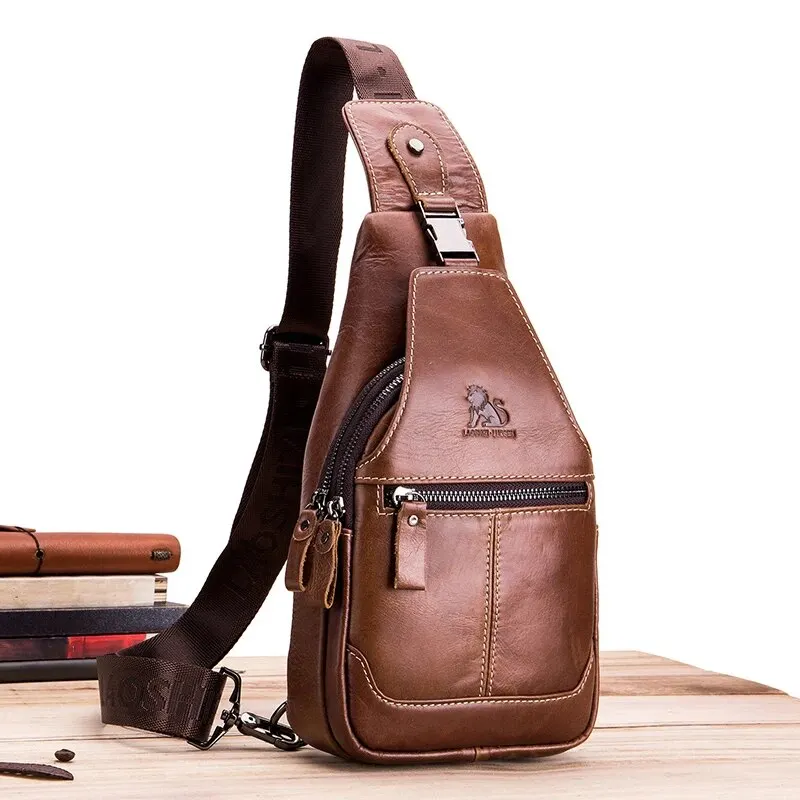
Failing to Account for Food and Water Volume
Problem: Many new backpackers calculate gear volume but underestimate how much space consumables require, especially for longer trips.
Solution: Allocate approximately 1.5-2 liters of pack space per day for food, plus appropriate water storage for your environment.
The “Buy Once, Cry Once” vs. Multiple Specialized Packs Debate
There’s wisdom in both approaches:
– Quality versatile packs cost more initially but provide better long-term value
– Multiple specialized packs offer optimal performance for specific activities
– Most experienced adventurers eventually develop a “quiver” of packs for different needs
– Begin with a versatile option in your most common size range, then add specialized packs as your experience grows
Alternative carrying styles like leather rucksacks offer different weight distribution properties that some find more comfortable, and exploring a comprehensive leather rucksack buyer’s guide can provide additional insights into these options.
13. Can One Backpack Size Work for Multiple Activities?
The quest for the perfect “do-everything” backpack is common, particularly for those new to outdoor activities or working within budget constraints. Understanding the possibilities and limitations of versatile packs helps set realistic expectations.
The Concept of the “Quiver of One”
A single backpack that handles most of your adventures:
– Typically falls in the 40-55 liter range
– Features adjustable compression to adapt to varying load sizes
– Includes removable components for customization
– Offers balanced suspension between lightweight and supportive
– Prioritizes durability to handle diverse conditions
Pros of the Multi-Use Approach
- Cost efficiency: Lower initial investment
- Simplicity: Familiarity with one pack’s features across activities
- Storage space: Requires less storage at home
- Mastery: Deeper understanding of how to optimize one system
- Environmental impact: Reduced consumption of materials
Cons of the Multi-Use Approach
- Compromise: Never perfectly optimized for any specific activity
- Weight penalty: Features needed for some activities become dead weight in others
- Durability concerns: Different activities stress different areas
- Feature mismatch: Organization suitable for hiking might not work for travel
- Transition time: Reconfiguring between activities requires effort
Where Versatility Works Best
- Weekend backpacking combined with day hiking
- Urban travel with light outdoor exploration
- Commuting with occasional short trips
- Activities with similar carrying needs and environmental conditions
Where Specialized Packs Become Necessary
- Technical climbing or mountaineering
- Extended wilderness expeditions
- Ultralight long-distance hiking
- Photography-focused adventures
- Extreme environmental conditions
For those seeking versatility between professional and leisure contexts, leather work backpacks offer elegant designs that transition smoothly between environments, while understanding waterproofing for leather bags ensures protection across various conditions.
14. Should You Consider a Backpack’s Growth Potential?
When investing in quality gear, considering future needs alongside current requirements can provide better long-term value. This “growth potential” approach requires balancing immediate comfort against anticipated changes in your activities or abilities.
Skill Progression Impact on Pack Needs
As you gain experience in outdoor activities, your gear requirements often evolve:
– Beginners typically need more volume due to less efficient packing and bulkier entry-level gear
– Intermediate adventurers often shift toward more specialized equipment that may be lighter but activity-specific
– Advanced practitioners frequently develop minimalist approaches requiring less volume
– Experts may then add volume back for specialized equipment or guiding responsibilities
This progression isn’t linear—a 65-liter beginner pack might shrink to a 45-liter intermediate pack, then diversify to include both a 30-liter technical pack and a 70-liter expedition model.
Youth and Growing Users
For younger users still growing physically:
– Adjustable torso length systems offer extended usability
– Modular components allow gradual capacity increases
– Some manufacturers offer youth-specific designs with growth accommodation
– Consider gender-neutral designs that adapt better to changing body proportions
– Balance current fit against maximum projected growth (typically 2-3 years)
Expandable Systems and Modularity
Modern pack design offers adaptability through:
– Expandable collars that add 5-15 liters when needed
– Removable top lids that can function as standalone daypacks
– Attachment systems for adding accessory pouches
– Adjustable compression that works effectively at varying fill levels
– Removable frame components for weight savings in less demanding conditions
The “Room to Grow” Philosophy
When considering future needs:
– Err on the larger side only if the physical fit remains appropriate
– Focus on adjustability features rather than simply more volume
– Consider how your activities are likely to evolve based on interests
– Evaluate if modular additions could provide flexibility without compromising fit
– Balance the certainty of current needs against the possibility of future ones
For those seeking adaptability across different contexts, convertible leather backpacks offer innovative designs that transform to meet changing requirements.
15. What If You’re Between Sizes? (When and How to Compromise)
Finding yourself between standard backpack sizes is common, particularly for those with proportions that don’t align perfectly with manufacturer sizing charts. Making the right compromise requires understanding which aspects of fit should never be sacrificed.
When to Size Up
Consider choosing the larger size when:
– You frequently pack bulky but lightweight items (sleeping bags, puffy jackets)
– Your torso measurement falls within 0.5 inches (1.3 cm) of the next size up
– The larger size offers more adjustability in the suspension system
– Your hip measurement is at the upper limit of the smaller size’s range
– You’re between seasons (e.g., spring when you might need both winter and summer gear)
When to Size Down
Opt for the smaller size when:
– You prioritize stability and balance, especially for technical activities
– Your torso measurement is within 0.5 inches (1.3 cm) of the smaller size
– You have a minimalist packing style or ultralight gear
– The smaller pack has better compression options for partially-filled loads
– You’re primarily using the pack in environments requiring agility and mobility
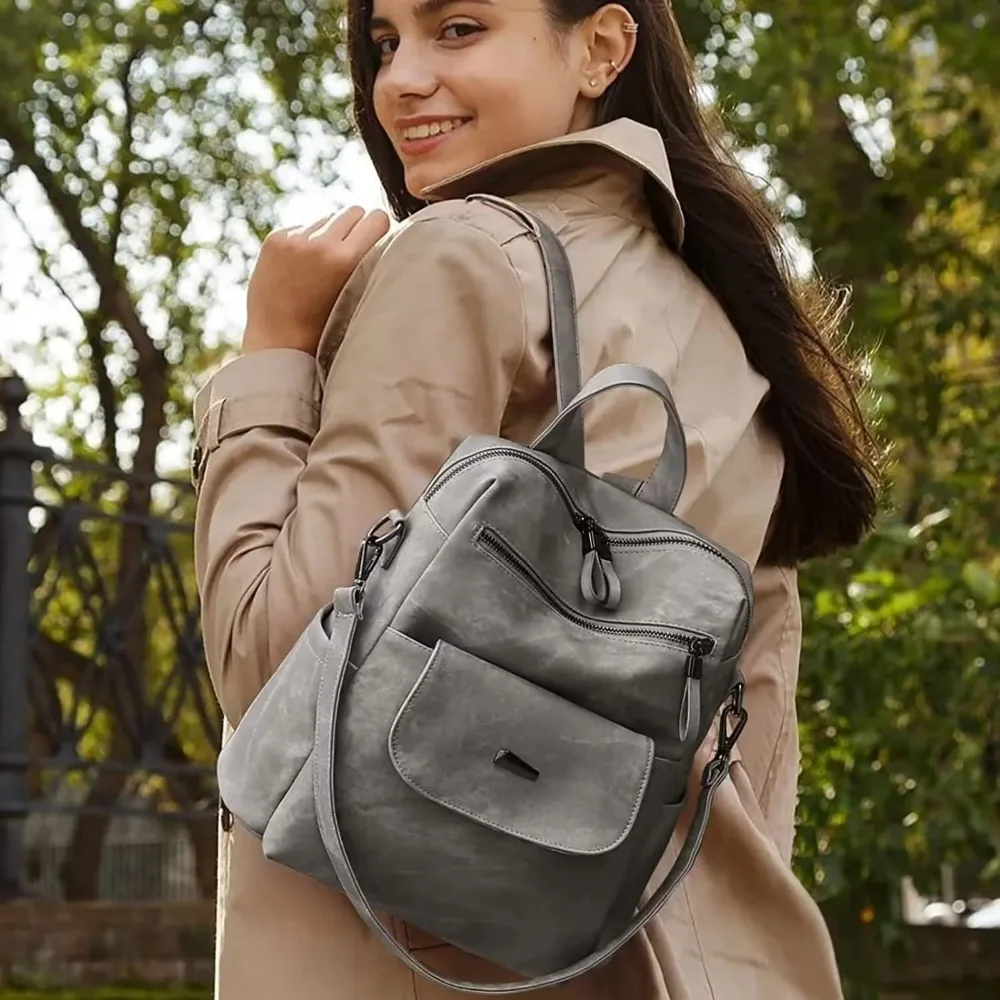
Physical Characteristics Creating Sizing Challenges
Certain body types frequently encounter sizing difficulties:
– Very tall, thin builds (long torso with narrow hips)
– Short torso with broader hips
– Athletic builds with V-shaped torsos
– Proportionally longer or shorter torsos relative to height
Aftermarket Modifications
When a perfect fit isn’t available off-the-shelf:
– Hip belt padding can be augmented or trimmed by professional gear repair services
– Shoulder strap angles can sometimes be adjusted
– Frame sheet modifications can improve back panel contour
– Lumbar padding can be added or removed to fine-tune fit
– Custom pack makers offer made-to-measure options for unique body proportions
For those seeking premium options with more extensive adjustability features, designer leather backpacks often incorporate more sophisticated fit systems and customization options.
16. How Leather Backpacks Differ in Sizing Considerations
Leather backpacks present unique sizing considerations compared to their synthetic counterparts. Understanding these differences helps you apply general sizing principles appropriately when selecting a leather pack.
Material Impact on Volume Capacity
Leather’s physical properties affect usable space:
– Full-grain leather is typically thicker than synthetic materials, reducing interior volume slightly
– Leather doesn’t stretch significantly, making overpacking more problematic
– Structured leather designs maintain their shape even when not full
– Internal organization in leather packs often prioritizes protection over maximum space efficiency
– Hardware and reinforcements tend to be more substantial, taking additional interior space
Break-In and Aging Effects on Fit
Unlike synthetic materials, leather changes over time:
– Leather softens and conforms to your body with use, improving fit
– Straps typically become more pliable and comfortable after a break-in period
– Weight-bearing areas develop a personalized molded fit over time
– Proper conditioning maintains flexibility while preventing excessive stretching
– Well-maintained leather adapts to your carrying style over months of use
Weight Considerations
Leather construction affects weight distribution:
– Leather backpacks generally weigh 15-30% more than comparable synthetic packs
– The additional weight is distributed throughout the pack, not concentrated
– Quality hardware adds weight but improves longevity and performance
– The inherent structure of leather often reduces the need for additional frame components
– Premium leather’s durability offsets weight considerations through longer lifespan
Support System Differences
The design philosophy behind leather packs often differs:
– Traditional leather packs may use simpler suspension systems
– Modern leather designs increasingly incorporate advanced ergonomic features
– Strap attachment points are typically reinforced for longevity
– Hip belts on leather packs may be designed more for stability than weight transfer
– Padding is often denser and slower to compress than synthetic materials
Summit Carry’s full-grain leather backpacks exemplify how premium materials can be incorporated into ergonomic designs. Understanding the differences between full-grain versus top-grain leather helps you make informed decisions about quality and performance, while leather backpack care and maintenance ensures your investment maintains its proper fit over years of use.
14 Inch Leather Laptop Backpack, Brown Leather Backpack, Men's Leather Backpack, Vintage Leather Backpack
Price range: $177.28 through $199.12 Select options This product has multiple variants. The options may be chosen on the product pageCarry On Leather Backpack, Roll Top Leather Backpack
Price range: $77.76 through $96.48 Select options This product has multiple variants. The options may be chosen on the product pageDesigner Men's Backpack, Men's Leather Laptop Backpack, Men's Leather Work Backpack
Price range: $158.04 through $160.04 Select options This product has multiple variants. The options may be chosen on the product pageBrown Leather Sling Backpack, Crossbody Leather Sling Backpack, Men's Leather Sling Backpack
Price range: $191.96 through $193.72 Select options This product has multiple variants. The options may be chosen on the product pageDesigner Mini Backpack, Mini Leather Backpack, Small Leather Sling Backpack, Women's Leather Backpack
Price range: $95.76 through $98.80 Select options This product has multiple variants. The options may be chosen on the product pageDesigner Mini Backpack, Designer Women's Backpack, Mini Leather Backpack, Women's Leather Backpack
Price range: $135.92 through $137.64 Select options This product has multiple variants. The options may be chosen on the product page
17. Is It Better to Have Extra Space or a Perfectly Filled Pack?
The debate between choosing a pack with room to spare versus one that’s perfectly filled is common among outdoor enthusiasts and travelers. Both approaches have merit depending on your specific needs and preferences.
The Case for Extra Space
Having additional room in your pack offers several advantages:
– Easier packing and retrieval of items without precise organization
– Accommodation for unexpected acquisitions during travel
– Better weight distribution through strategic placement rather than forced packing
– Reduced stress on zippers, seams, and closure systems
– More effective use of compression systems to stabilize partial loads
– Flexibility for seasonal gear variations without changing packs
However, excess space can encourage overpacking and create stability issues if items shift during movement.
The Case for Perfect Filling
A pack filled to its optimal capacity provides:
– Better balance and weight distribution with minimal movement of contents
– Forced discipline in packing decisions and item selection
– Reduced overall weight by eliminating the temptation to add “just one more thing”
– Improved stability during active movements like climbing or skiing
– Less fabric and material flapping or catching on obstacles
– Often a sleeker, more streamlined appearance
The downside is reduced flexibility and potentially difficult access to deeply packed items.
Compression Systems and Their Effectiveness
Modern compression features help bridge this gap:
– External compression straps can reduce volume by 15-25% when not needed
– Internal compression systems help stabilize partial loads
– Expandable collars and pockets provide temporary additional space
– Modular attachment systems allow external carrying when necessary
– Roll-top closures adjust naturally to varying fill levels
Finding Your Balance
The ideal approach depends on:
– Your typical activities (technical pursuits favor perfect filling)
– Experience level (beginners benefit from some extra space)
– Environmental variability (changing conditions favor extra room)
– Trip duration (longer trips benefit from perfect organization)
– Personal comfort with tight packing versus flexible organization
Most experienced adventurers eventually develop an intuitive sense of their ideal fill level—typically 80-90% full for optimal weight distribution combined with reasonable access.
18. Final Checklist: Ensuring You’ve Made the Right Backpack Size Choice
Before making your final backpack size decision, use this comprehensive checklist to verify you’ve considered all critical factors. This systematic approach helps avoid expensive mistakes and ensures your pack will serve you well for years to come.
Physical Fit Verification
- [ ] Torso length matches the pack’s size range
- [ ] Hip belt centers comfortably on iliac crest
- [ ] Shoulder straps follow contour of shoulders without gaps
- [ ] No pressure points remain after proper adjustment
- [ ] Load lifters position at approximately 45° angle
- [ ] Sternum strap adjusts to comfortable position
- [ ] Back panel contacts body without excessive pressure or gaps
Volume Needs Assessment
- [ ] Capacity suits your typical trip duration (not just occasional extremes)
- [ ] Size accommodates specialized gear for your primary activities
- [ ] Sufficient space for maximum food and water requirements
- [ ] Appropriate for seasonal gear variations in your environment
- [ ] Compatible with your personal packing style and preferences
- [ ] Meets airline carry-on requirements if relevant to your needs
- [ ] Balances current needs with realistic future requirements
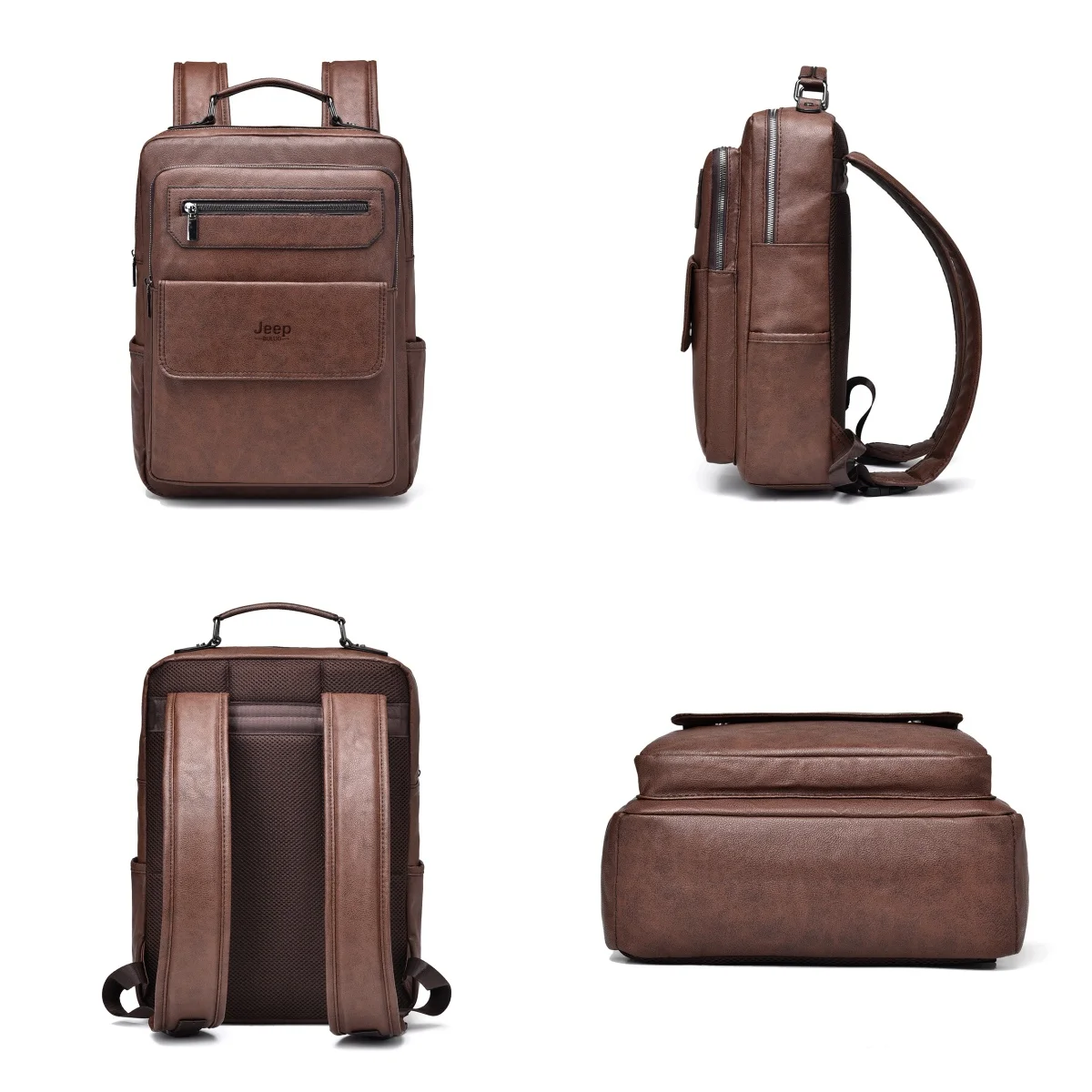
Feature and Function Confirmation
- [ ] Access style (top-loading, panel-loading, etc.) matches your preference
- [ ] Organization features align with your typical gear and needs
- [ ] Attachment points available for activity-specific equipment
- [ ] Compression system adequate for your variable loading needs
- [ ] Weather protection appropriate for your environments
- [ ] Durability level suitable for your intended use frequency and conditions
- [ ] Weight acceptable for your physical capacity and journey length
Red Flags to Reconsider
- Significant discomfort during in-store testing with weighted pack
- Inability to properly adjust to your body despite correct sizing
- Features that seem excessive or insufficient for your needs
- Noticeable restriction of movement during testing
- Pack that feels unwieldy or unbalanced when properly loaded
- Size that dramatically exceeds or falls short of calculated needs
- Gut feeling that something isn’t quite right despite specs matching
For business professionals seeking functionality with style, leather briefcase backpacks offer elegant organization while maintaining proper sizing principles, and understanding leather bag treatment for outdoor use ensures your investment remains protected regardless of environment.
Finding the perfect backpack size involves balancing multiple factors specific to your body, adventures, and preferences. By methodically considering each aspect covered in this guide, you’ll be well-equipped to make a confident decision that enhances your comfort and enjoyment on every journey. Remember that the right size is ultimately the one that becomes virtually unnoticeable during your adventure—supporting your activities without calling attention to itself through discomfort or limitations.

